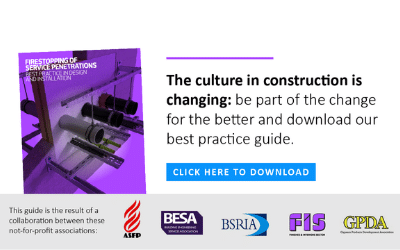“Never assume” says Joe Cilia, FIS Technical Director, especially when it comes to specifying and installing firestopping products. There have been too many examples where non-compliance has led to tragedy.
During a storm in January 2016 nine tonnes of masonry fell at Oxgangs Primary School because of a lack of compliant brick ties, this led the inspector to produce a report on the compliancy of the building itself which, amongst other failings, highlighted that the firestopping around services wasn’t compliant and, in some cases, didn’t exist. Previously, a fire at Lakanal House on 3 July 2009 killed six people and at least 20 were injured when a high-rise fire developed and spread through a number of fl ats in the 12-storey building. Breaches in compartmentation were shown to contribute to the fire spreading.
Never assume
These two tragedies should have provided the catalyst to drive changes in the way that firestopping is considered during the design stages of a building and to put processes in place to ensure that compliant solutions are used; yet there are still almost daily examples where assumptions are made on the selection and installation of firestopping products where either inappropriate products are used or they are used outside of their field of application. Often left as a contractor’s design portion, the responsibility for the selection of a product is left to the installer on site, based often on past experience or even worse, assumptions.
Everyone who has followed the BBC podcasts on the Grenfell Tower enquiry will appreciate the argument of ‘I assumed’ really does not stand up to scrutiny.
In her report following the Grenfell Tower disaster, Dame Judith Hackitt said that industry shouldn’t wait to be told what to do. Armed with this remit FIS and the Building Engineering Services Association (BESA), called others in the field together including the Association for Specialist Fire Protection (ASFP), Building Services Research and Information Association (BSRIA) and the Gypsum Products Development Association (GPDA) to write: ‘Firestopping of service penetrations, best practice in design and installation’.
The guide, which was published in September, is freely available from the FIS website and provides guidance to everyone involved in the design and construction of buildings where services pass through compartment walls and floors.
The guide uses a series of golden rules which are aligned with the RIBA Plan of Work to demonstrate what should be considered at each stage. It also demystifies the terms used across the sector, for example ‘drylining’ is known as a ‘flexible construction’ in firestopping terms.
Fully developed design
Any well delivered project needs early collaboration, this includes working with the installers of the drylining and the firestopping, something in fact that will become mandatory in the new Building Safety Bill where the design must be fully developed before planning can be submitted, so the good news is that you can expect calls at the beginning of the project rather than a quick call to close up at the end.
To help the team ensure that a compliant solution is designed, the guide includes a list of 34 questions that sit alongside the nine golden rules to ensure that all aspects of the project are considered. They include:
• the mixture of services in the hole;
• the scheduling of the work to ensure that the drylining can be compliantly installed before the services; and
• the issues such as the size of the prepared opening and proximity of the opening must be compliant with the system owner of the drylining system.
Remember — don’t assume that if it was OK before it will still be OK this time. We are aware that some suppliers are revaluating what details are being used as common practice based on site-specific projects and have reissued a list of standard details.
Dame Judith Hackitt said in a foreword to the guide: ‘Some wait to be regulated before they change, but it is now clear that radical reform is coming. Industry must prepare and should be taking action ahead of legislation coming into force. Initiatives like this help to boost confidence in what to do and show that the industry is capable of taking responsibility rather than waiting for others to produce guidance. It gives me hope that the culture in construction is changing.’
The guide is free to download at: https://www.thefis.org/membershiphub/publications/best-practice-guides/firestopping-of-service-penetrations/


